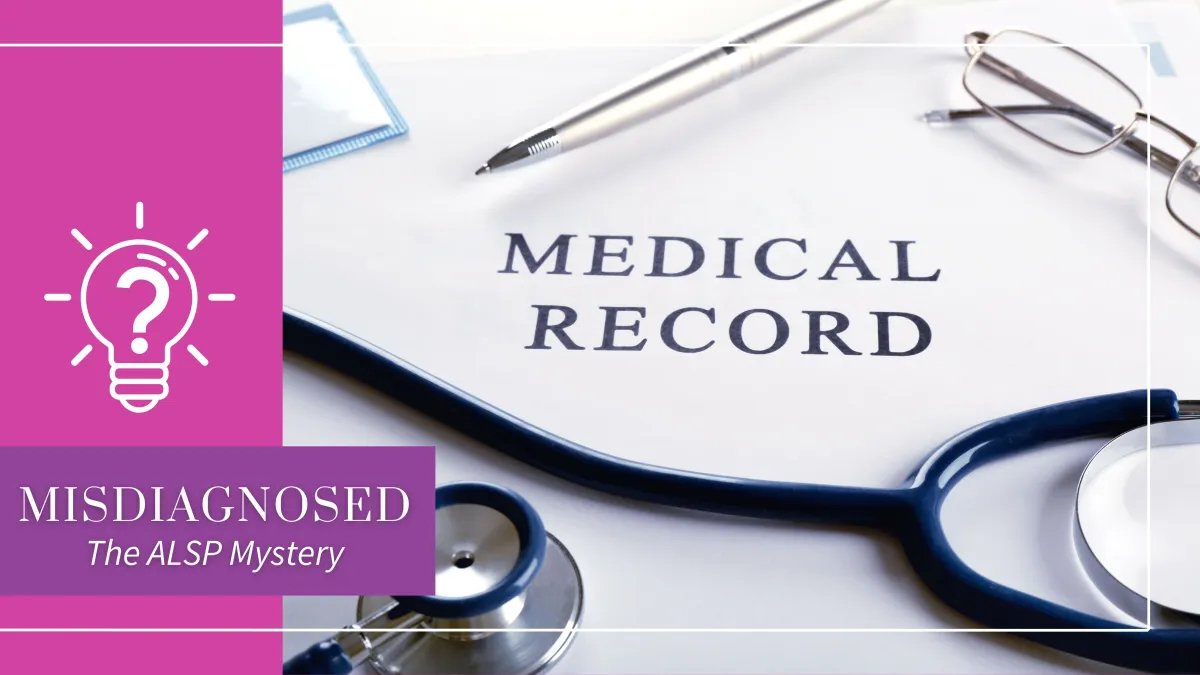Misdiagnosed The ALSP Mystery
July 2, 2024
Raise your hand if you have ever had to go to the doctor more than once to get accurately diagnosed.
I guarantee that most of us have experienced this problem at least once (probably more) in our lifetimes. Perhaps the doctor missed a fractured bone on an x-ray. Possibly a strep test resulted in a false negative. Or maybe a doctor wasn’t even aware that a certain condition existed so it wasn’t even considered as a possible diagnosis.
Sadly, that last example happens more than anyone wants to acknowledge. There are approximately 7,000 rare diseases that have been identified, and it is no shock that when looking for a plausible explanation to health woes, a doctor is less likely to consider a rare cause over a more common cause. Plus, who can really remember all the possibilities. I don’t even know if I know 7,000 different words, much less 7,000 different disease names and their symptoms. Even if we narrow down to specialty types like rare neurological diseases, it will span into the hundreds.
ALSP is one of many rare, neurological diseases, and many people living with ALSP have to fight for a correct diagnosis. Only about ¼ of ALSP patients are diagnosed correctly the first time around. For most patients, it is a 2-3 year process to finally receive that right diagnosis. Sadly, by then, their disease is usually so far progressed they do not qualify for potential research or therapy options.
There are many roadblocks to obtaining a correct diagnosis. I would argue that the number one reason ALSP is under or misdiagnosed is ignorance of the disease. Many, if not most, doctors have never heard of ALSP. It’s impossible to diagnose a disease you’ve never heard of.
Secondly, ALSP is a highly variable disease. In plain language it means that no two manifestations of ALSP look the same, even within the same family. Age of symptom onset can range from approximately 30-50 years of age. That’s a big time span and we have patients that are outliers to that range – some diagnosed in their 20s, others in their 60s.
Initial symptom presentation is also widely variable. One patient may initially exhibit cognitive symptoms such as executive dysfunction, meaning patients have trouble problem solving, planning ahead, multi-tasking, and reasoning. Cognitive symptoms may include progressive dementia – changes in memory that get worse, and some ALSP patients experience changes in speech. Some experience trouble finding words and/or slurring their speech. Others lose the ability to talk completely.
Another patient may initially exhibit behavioral symptoms such as mood and personality changes like depression, anxiety, or agitation. They may show disinhibited behavior such as lack of self- control or poor judgment. Or they may suffer from severe apathy.
Still another patient may initially exhibit motor changes. This includes things like rigid, weak muscles and muscle spasms and tremors. Gait changes – such as shuffled walking, hunched posture, and reduced swinging of arms may be present. Changes in coordination are also observed making holding objects challenging and increasing the risk of falls.
Another obstacle to obtaining a correct diagnosis is that ALSP symptoms overlap with other, more common diseases such as MS, FTD, Parkinson’s, and early onset Alzheimer’s. Doctors are more apt to go with a more common diagnosis rather than pursuing other testing for rare diseases.
I believe the final barrier to correctly diagnosing ALSP is that many doctors do not understand the importance of or utilize genetic testing. The best and quickest way to get a correct ALSP diagnosis is genetic testing, but genetic testing is not in the tool kit of most doctors and therefore genetic diseases often get overlooked.
So, what can we do to break down some of these barriers and overcome these roadblocks? I won’t lie. It won’t be an easy or quick process. We have many advocates ranging from family members to doctors that are working to spread the word about ALSP. They are doing this by taking every opportunity to speak with providers and colleagues about this disease, what to look for, and how to test for it. Already we are seeing the fruits of their labors. But we are not done. Many doctors have yet to hear about ALSP, when to suspect it, and how to test for it. Sisters’ Hope Foundation has created a Doctor Awareness Toolkit that can be used to share pertinent information about ALSP. It is a series of 7 mailings that communicate important facts about the disease. We are in the process of mailing this out to 500 doctors. I know! Amazing! But we have to assume that many of the mailing will be discarded without a glance. We will not be deterred. And we need your help! Please download a copy of the Doctor Awareness Toolkit (Doctor Awareness Toolkit) and get it into the hands of your local doctors – whether you send it out in mailings, share via email, or hand it to your doctor in person. The more who know about ALSP, the wider our reach, the more times our patients will be accurately diagnosed, and the more times we have an opportunity to support those living with this rare disease.

